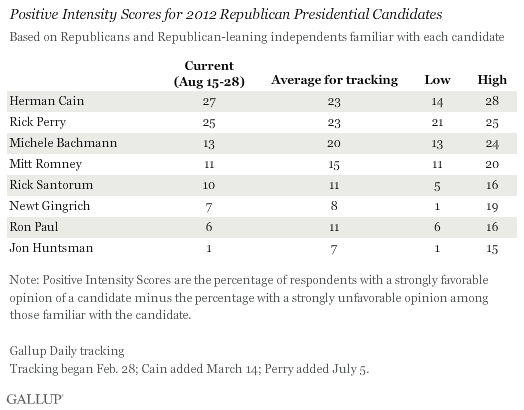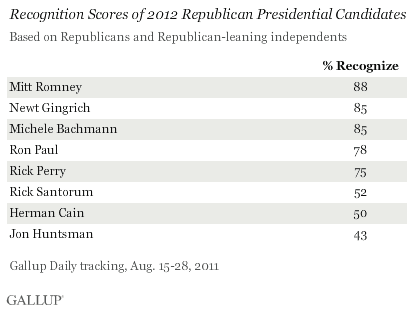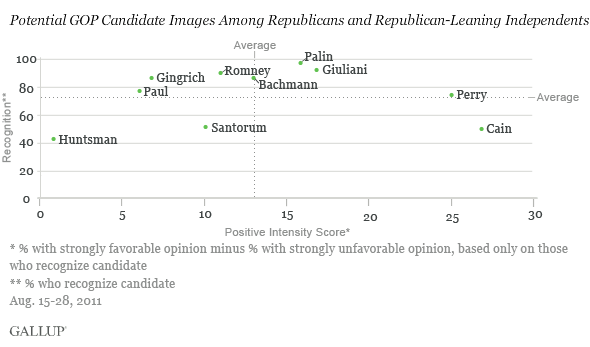PRINCETON, NJ -- Herman Cain and Rick Perry continue to generate strongly favorable impressions among Republicans familiar with them. Meanwhile, those familiar with Mitt Romney, Michele Bachmann, and Ron Paul express less intensely positive opinions of those candidates now than at any point this year. The result is a clear separation of 12 percentage points between the top and middle tiers of Republican presidential candidates in Gallup's Positive Intensity Score from Aug. 15-28 Gallup Daily tracking. The average Positive Intensity Scores show much smaller gaps between the current top- and middle-tier candidates.

Two potential candidates included in the measurement, Sarah Palin and Rudy Giuliani, fall between the middle and top tiers, with current scores of 16 and 17, respectively.
Of all the candidates Gallup tracks, Jon Huntsman has the lowest score, 1. That is also his personal low, and he is one of four candidates, along with Romney, Bachmann, and Paul, to have a personal low in the current data. Newt Gingrich, still mired in the lower tier of candidates with Huntsman and Paul, has shown some improvement in his score in recent weeks, now 7 after descending to 1 at the end of July.
Perry, Romney, Paul, and Bachmann rank as the top four candidates in Gallup's latest GOP nomination preference poll, conducted Aug. 17-21. However, these four candidates' positive intensity trends have diverged in recent weeks, with Perry holding steady or improving but Romney, Bachmann, and Paul generally declining. This is the case even after Bachmann and Paul had the strongest performances in the recent Iowa Straw Poll, though the event was perhaps overshadowed by Perry's long-rumored official entry into the race that same weekend.

Perry has maintained a strongly positive image as he has become much better known among Republicans nationwide. Three weeks ago, 54% of Republicans recognized his name; now, 75% do. That has raised his recognition to an above-average level for the first time.
Perry is now one of five official candidates, along with Romney, Bachmann, Gingrich, and Paul, who is known by at least three-quarters of Republicans. Non-candidates Palin (97%) and Giuliani (91%) remain slightly better known than the announced field of candidates. Cain, Huntsman, and Rick Santorum continue to lag in familiarity.

Lack of familiarity appears to be holding Cain back. Despite strongly favorable reviews among those who know him, Cain registers minimal support in nomination preference polls. In Gallup's latest update, 4% of Republicans and Republican leaners say they are most likely to support Cain for the party's 2012 nomination.
Perry's continuing rise in recognition would seem to solidify his status as the current candidate to beat -- high in both recognition and positive intensity. Huntsman appears to be in the weakest position now, with low recognition and low positive intensity.

Implications
Perry's image remains positive among Republicans familiar with him, even as that group has rapidly expanded in recent weeks from slightly over half to three-quarters of all Republicans. Many other GOP presidential candidates who have shown gains in recognition this year, including Bachmann, Huntsman, and former candidate Tim Pawlenty, saw their Positive Intensity Scores decline as they became better known.
Now, Perry enjoys some separation between himself and his most likely challengers in both positive intensity and support for the nomination (given his 12-point lead over Romney in the latest update), marking him as the clear front-runner at this point in the campaign.
Survey Methods
Results are based on telephone interviews conducted as part of Gallup Daily tracking Aug. 15-28, 2011, with random samples of Republicans and Republican-leaning independents, aged 18 and older, living in all 50 U.S. states and the District of Columbia. Questions asking about the 10 potential candidates measured in this research were rotated among randomly selected samples of Republicans each night; over the 14-day period, each candidate was rated by approximately 1,200 Republicans and Republican-leaning independents.
For the overall ratings of each potential candidate among Republicans and Republican-leaning independents, including recognition scores, one can say with 95% confidence that the maximum margin of sampling error is ±3 percentage points. For the Positive Intensity Score for each candidate, the maximum margin of sampling error varies depending on the size of the group recognizing the candidate.
Interviews are conducted with respondents on landline telephones and cellular phones, with interviews conducted in Spanish for respondents who are primarily Spanish-speaking. Each sample includes a minimum quota of 400 cell phone respondents and 600 landline respondents per 1,000 national adults, with additional minimum quotas among landline respondents by region. Landline telephone numbers are chosen at random among listed telephone numbers. Cell phone numbers are selected using random-digit-dial methods. Landline respondents are chosen at random within each household on the basis of which member had the most recent birthday.
Samples are weighted by gender, age, race, Hispanic ethnicity, education, region, adults in the household, and phone status (cell phone only/landline only/both, cell phone mostly, and having an unlisted landline number). Demographic weighting targets are based on the March 2010 Current Population Survey figures for the aged 18 and older non-institutionalized population living in U.S. telephone households. All reported margins of sampling error include the computed design effects for weighting and sample design.
In addition to sampling error, question wording and practical difficulties in conducting surveys can introduce error or bias into the findings of public opinion polls.
For more details on Gallup's polling methodology, visit www.gallup.com.
